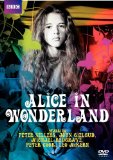| Reviews & Columns |
|
Reviews DVD TV on DVD Blu-ray 4K UHD International DVDs In Theaters Reviews by Studio Video Games Features Collector Series DVDs Easter Egg Database Interviews DVD Talk Radio Feature Articles Columns Anime Talk DVD Savant Horror DVDs The M.O.D. Squad Art House HD Talk Silent DVD
|
DVD Talk Forum |
|
|
| Resources |
|
DVD Price Search Customer Service #'s RCE Info Links |
|
Columns
|
|
|
Alice in Wonderland (1966 BBC version)
Far better, I suspect, than anything you're going to see in that 3D version this weekend. BBC Video and 2 Entertain, no doubt hoping to soak up a little of that Tim Burton Alice in Wonderland promotional gravy, have re-released Alice in Wonderland, the haunting, nightmarish 1966 BBC Television version written and directed by Jonathan Miller, and starring Peter Sellers, Sir John Gielgud, Sir Michael Redgrave, Wilfrid Brambell, Peter Cook, Alan Bennett, John Bird, Leo McKern, andAnne-Marie Mallik as Alice. Shot in pinpoint, ghostly black and white, with a dream-like editing schematic, actors dressed not in costumes but in period clothes, and a jarring, seductive, beautiful score by Ravi Shankar, this Alice in Wonderland is like no other version you'll see of the Lewis Carroll classic. Home Vision apparently released this in 2003; that disc's director's commentary and the Cecil Hepworth 1903 silent version of Alice are ported over for this edition, while some additional vintage BBC bonuses bump this up a notch over the previous release.
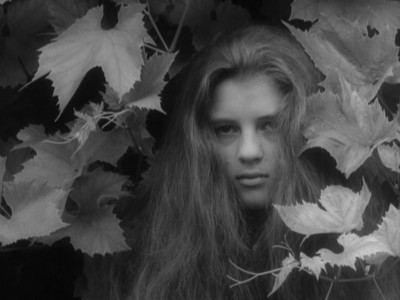
Staying remarkably faithful to events and dialogue in the Carroll book, Alice in Wonderland begins with Alice (Anne-Marie Mallik) and her stern sister (Jo Maxwell-Muller) primped and primed by their nonsensically-muttering nurse (Freda Dowie) for a typically Victorian excursion out into nature: they're heavily costumed in the fashion of the day; their hair is carefully coiffed, and they are in possession of a book so they may quietly sit and read - the pictures of gentle Victorian childhood innocence and propriety. Sitting in the hot sun, perspiring, Alice removes her hat, lays down in the grass, and begins to dream. Her sister is no longer there, but the White Rabbit (Wilfrid Brambell) is, irritatedly waving his walking stick to get the attention of the off-center-gazing Alice. Following the White Rabbit through, not "down," the rabbit hole, Alice walks through a decrepit military hospital where she eventually comes to a room. After looking out the tiny door (where she sees people enjoying a summer afternoon), she drinks a potion (appropriately marked, "Drink Me") that makes her smaller; however, she left the door's key on the table that towers above her, so she eats a cake marked "Eat Me," and grows big again. Eventually, she meets Mouse (Alan Bennett) and Dodo (Finlay Currie) and other animals who engage in a pointless "Caucus-race," before she finds herself in a small cottage, growing big again as she hears the frightening sounds of animals outside the cottage.
Escaping the cottage and the White Rabbit, Alice finds herself in another building, this time with Caterpillar (Sir Michael Redgrave), who fustily dusts little architectural models (Alice shrinks and finds herself in one eventually) before he tells her to "keep your temper," which she ignores. Hearing plates smashing in a kitchen, Alice tries to enter, but the Frog Footman (John Bird) tells her the only thing he can do for her is nothing...to which she responds he's idiotic. Once inside the kitchen, she watches the Duchess (Leo McKern) roughly treat her baby, singing a lullaby, while the Peppercook (Avril Elgar) smashes dishes. Suddenly outside, Alice discovers the baby she's been holding, given to her by the Duchess, is really a pig, and lets it go. Alice then comes upon a tea party given by the Mad Hatter (Peter Cook), the March Hare (Michael Gough), and the Dormouse (Wilfred Lawson). Alternately rambling on and sitting silently, the tea party goes on forever, before Alice leaves and encounters the Gardener (Gordon Gostelow), who is painting white roses red for the Queen of Hearts (Alison Leggatt). Soon, the Queen, the King of Hearts (Peter Sellers), and the Knave of Hearts (Peter Eyre), arrive by procession, and Alice follows along for a croquette match (after defying the Queen when Alice is sentenced to beheading: "Off with her head!"). Alice gets an unwanted lesson in morals from the nattering Duchess, before the Gryphon (Malcolm Muggeridge) takes her to the sea to see the Mock Turtle (Sir John Gielgud), who can't finish his life story because he never starts it. The Mock Turtle and the Gryphon dance at the sea edge, before Alice finds herself at Court, where she's on trial, and where she refuses to be quiet as the impotent Queen screams over and over again, "Off with her head!" Alice awakes in the tall grass, and leaves with her sister.
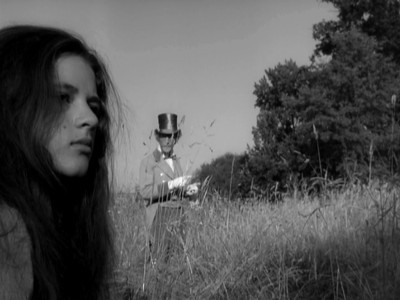
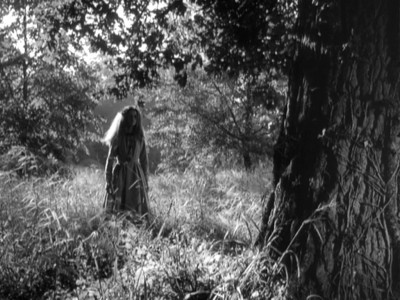
I had no idea what to expect from this BBC production of Alice in Wonderland when I received this disk. I had heard about the film, and its reputation as a strange, unorthodox (yet curiouser and curiouser still, a faithful) adaptation preceded it. Watching the movie, I was immediately taken by the fact that director Jonathan Miller's dream-like vision here is unlike any other "sunny," "happy," or "delightfully mad," version I've ever seen of the story. Whereas the Disney version (which I adore, despite widespread criticism of it) is about as far as one can go in the direction of taking the Carroll work and turning it into a colorful, childish, child-like fantasy (Miller makes a point on the commentary track of saying he particularly hated the Disney version), Miller's Alice in Wonderland is a dark, nightmarish excursion into pointless, almost listless madness...which makes it even more off-putting and uncomfortable in its rigid diffidence. Shot by cinematographer Dick Bush in a strange combination of a stiff, formal Daguerreotype-approximated aesthetic filtered through silent film framing, and a 60s gothic horror film (full of grotesque, fish-eye lens close-ups and hyper-real deep-focus scenes that always seem to suggest some kind of seething, on-the-verge violence), Alice in Wonderland doesn't look like anything I've ever associated with the literary source. Gone are the expected animal heads and costumes for the actors; gone largely are any elaborate, colorful special effects shots; gone almost completely are any moments of fake whimsy, or gaiety, or manic slapstick which often seems to get slapped on other adaptations of Carroll's book.
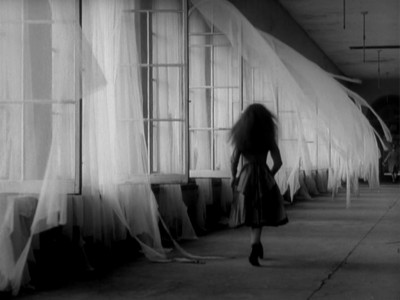
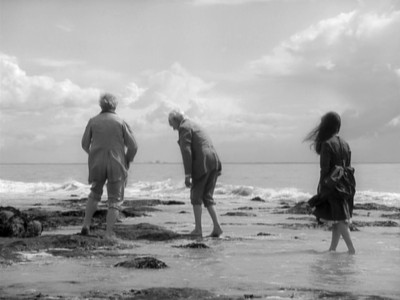
Instead, Miller gives us an Alice who sleepwalks through increasingly maddening scenes that, although she says she's a bit confused by them on the soundtrack, she doesn't appear fazed by them at all. Miller states in his commentary track that in this adaptation, he wanted to recreate the experience he had as a boy reading the book (he found it a frightening nightmare), along with his later re-readings where he sensed the deep melancholia of the book. And to a scene, he accomplishes this masterfully. The very first shot of the film sees a spectral, eerie, deeply morose Alice, with dark circles under her eyes, staring out blankly from the leaves - appearing more like a ghost from Henry James rather than the traditional stereotype we have of Alice as a spunky, cheerful, delightfully confused little girl. Coming upon this off-putting Alice, we wouldn't want to help her through her adventures; we would want to exit stage right, pronto. And with this pensive, vague poltergeist-like Alice, Miller is particularly good at creating an unsettling, nightmarish world out of Wonderland for her to roam. Filling the soundtrack with the ominous, overpowering sounds of angry insects, Miller not only suggests that Wonderland, right within the "garden of Eden England" subconscious of Alice, is a dangerous jungle, but that death walks along with this dead-like Alice. Miller's shot of a staring, motionless Alice laying in the grass, the soundtrack filled with angry flies, might as well suggest a corpse rotting in the sun as it does a young girl overcome by the heat and ready to nap. Miller's soundtrack is full of frightening jolts and undercurrents, from the scary, plinky music Shankar provides when Alice drinks the "Drink Me" potion, to the terrifying animal grunts and screams outside when she's in the cottage (he even uses the music to frightening effect, such as when Alice enters the Court, and a traditional hymn blasts forth, overbearing, like the wrath of God).
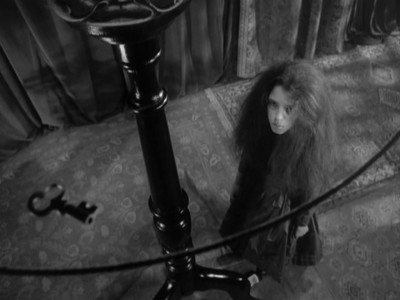
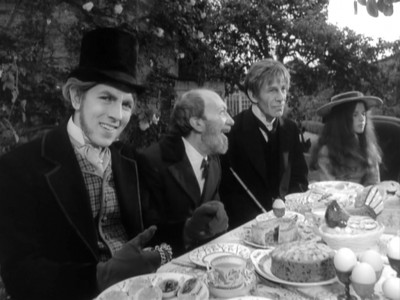
Miller's insistent dream-like aesthetic carries over into the visuals, as well. Miller and cinematographer Dick Bush achieve some remarkably simple - and quite disturbing - effects shots of Alice changing in size by extra-wide lens and foreshortening, with a insolent Alice often staring right back at us as we realize she's not as she was before. The film's most alarming visuals have to be during the cottage sequence, when not only is Alice grotesquely enlarged within the room, she also finds herself sitting in front of a mirror, whispering she doesn't know who she is, as she combs her hair slowly over the front of her face like a deeply disturbed mental patient. Almost every scene in Alice in Wonderland keeps us off our feet visually, aurally, logically, emotionally - just as we are in our own dreams - in a sustained effort by Miller that's remarkable. Indeed, the nightmare begins before Alice's actual dream begins, when Miller's first shot shows Alice staring through the leaves, before slowly closing her eyes. Is that first shot the beginning of her sleep, and dream? That may explain the next scene that has her nurse muttering incoherently as she prepares the girls for going out. Most fans of the story know the "dream" begins when Alice lays down and falls asleep in the grass, but Miller wants us edgy and anxious right off the bat, with abrupt jump cuts and switches that denies us any bearings as to a time-frame or a sense of Alice going from point A to B to C (Miller's editing framework is wonderfully arbitrary - we never get a point of reference).
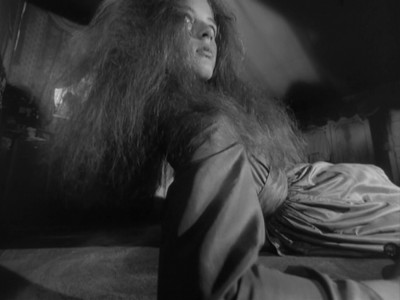
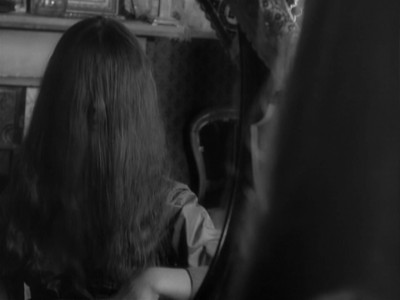
Although he doesn't state it in the commentary track, Miller also seems to be trying to make this Alice in Wonderland as unlike any other adaptation as he can. Alice in Miller's film can hardly even be called the protagonist. She somnambulantly walks through Wonderland, giving as good as she gets from the mad people she encounters, usually in the form of a snotty rejoinder, a sly insult (she casually explains to the Caterpillar she can't explain herself to him because she's not herself today), or an imperious, petulant, childish toss of her hair when she's had enough of a scene or character. She often doesn't speak (except in narration), and she won't even look most of the characters in the face. This is hardly the Alice of any other adaptation I've seen. Aiding this "anti-Alice in Wonderland" structure, Miller goes out of his way to negate as many of the broader elements and scenes from the story as he can to steer clear of those "showy" moments most other filmmakers highlight. There's no disappearing Cheshire cat grin; the pool of tears last only a few seconds; and no actor wears an animal head or silly animal costume. Scenes in the book and in other adaptations that seem to naturally lend themselves to comedy or action, like the croquette game, are dealt with here in a subdued, almost subversive manner (we see a man trying to hit a ball in a stream...while someone in a wheelchair sits in the middle of the water. No sense of a "game" is attempted except as a pointless social exercise). All of the words and scenes are Carroll's (Miller discouraged actors' improvs, although he let a few stay in), but Miller interprets them as a dream gone horribly wrong...with the dreamer just as mad-seeming as those she encounters.
On the commentary track, Miller also makes a point, several times, that he wanted this Alice in Wonderland to resemble those long, hot summer days of childhood that never ended...until one grew up (presumably into a facsimile of one of the mad characters Alice finds in Wonderland). He speaks of these days as ones of innocence and pleasure, interrupted by the realities of the present (personified by Alice's journey in Wonderland). But as I was listening to Miller, I wondered why he kept using the word "interminable" when describing those long, hot summer days of youth. Isn't that word often used for a negative connotation? Miller states that over a half-hour of footage was cut from the final print, material that specifically went towards creating a sense of a never-ending summer day. Could the feel of that rough cut have been more in line with something "interminable" in atmosphere and context? It's difficult to say. But certainly Miller approximates that sensation in the Mad Hatter's Tea Party sequence, where Miller uses ellipse after ellipse to give the feeling of an insufferable, unending social interaction. Peter Cook, quite hilarious, snivels through his nose and nods at everything, while Michael Gough scowls and Wilfred Lawson barely gets out enough breathe to tell a tiny bit of the "treacle well" story. It's an absolutely crushing moment in the film, with Miller taking Carroll's intent (the boorishness of pointless social activities) and visualizing it with a completeness of intent that's astounding. This isn't just the single most intriguing version of Alice in Wonderland I've ever seen - it's one of the best English films from the 1960s.
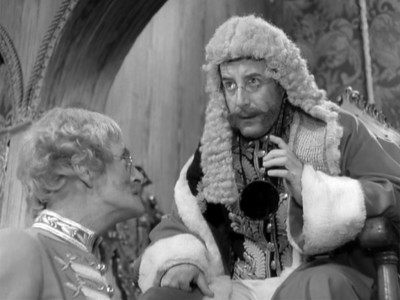
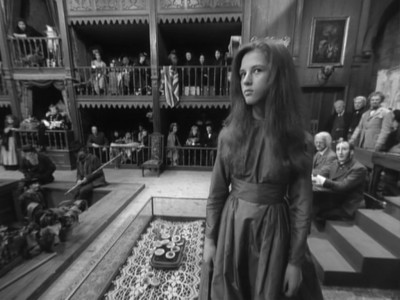
The DVD:
The Video:
Fortunately, the BBC didn't get its way by shooting this in color video (their videography in 1966 was laughably subpar). Miller insisted on 35mm black and white (even that was a step up from the usual 16mm British television routinely employed), and the results are astounding. This transfer sports a creamy, almost flawless print with an incredibly delicate gray scale and blacks that hold. I saw no compression issues to speak of here. One of the most beautiful black and whites films I've ever seen.
The Audio:
There were some pops and snaps during the Court sequence, but other than that, the English mono track was startlingly clear. English subtitles are available.
The Extras:
Here's where owners of the previous Home Vision release may want to double-dip. First, all of the extras, save the liner notes, from that release have been included here. Director Jonathan Miller's commentary is quite informative as he tracks the process of getting this film made, while offering a few interpretations of what he was trying to achieve. The Cecil Hepworth-directed 1903 version of Alice in Wonderland is also included, with film historian Simon Brown giving out quite a bit of info on its making during the short 8:31 run time. And the gallery of photos by Terence Spencer (shot for Life magazine), have also been included (there are some interesting color ones, giving you an idea how all of this must have looked to the cast and crew during filming). Two new bonuses are included on this BBC release. First, a behind-the-scenes featurette, Ravi Shankar Plays for Alice, running 9:27, is included here (it appears to be a snippet from a longer feature). Shankar and director Millar are shown working on the soundtrack (the BBC facilities look laughably primitive), giving us a good idea of the difficulty of scoring a film. And last, Alice, the 1965 biopic written by Dennis Potter (The Singing Detective) that appeared on the BBC series, The Wednesday Play (the same series Alice in Wonderland appeared on in 1966), is included here. Starring George Baker (On Her Majesty's Secret Service) as the Reverend Charles Lutwidge Dodgson ("Lewis Carroll's" real name), Alice makes no bones about suggesting that Dodgson was romantically infatuated with 11-year-old Alice Liddell (Deborah Watling), the supposed inspiration for Alice's Adventures in Wonderland - a theory that is still being debated today. It's an intense 70-minute drama, beautifully crafted, with a terrific performance by Baker as the stammering, love-sick Dodgson.
Final Thoughts:
My new favorite film version of Alice's Adventures in Wonderland, and one of the best British films - TV or the big screen - of the 1960s. Producer, director and adapter Jonathan Miller achieves a remarkably consistent aesthetic vision of Alice in Wonderland as a waking, walking gothic nightmare, with a somnambulant, surly Alice listlessly jousting with a sterling British cast made up not as animals, but as quite mad Victorian stereotypes. Not one element is out of place here: cinematography, soundtrack, script, performances. Don't watch it on a bright, sunny afternoon as you would with any other Alice adaptation. Watch it at night, with the lights off. Strange, unreal, frightening (as well as funny in spots, particularly Peter Cook's sniveling Mad Hatter and an absolutely brilliant John Bird as a double-talking Frog Footman). The additional extras top the previous 2003 release. I'm giving Alice in Wonderland our highest ranking here at DVDTalk: the DVD Talk Collector Series rating. It's one of my favorite releases so far this year.
Paul Mavis is an internationally published film and television historian, a member of the Online Film Critics Society, and the author of The Espionage Filmography.


|
| Popular Reviews |
| Sponsored Links |
|
|
| Sponsored Links |
|
|
| Release List | Reviews | Shop | Newsletter | Forum | DVD Giveaways | Blu-Ray | Advertise |
|
Copyright 2024 DVDTalk.com All Rights Reserved. Legal Info, Privacy Policy, Terms of Use,
Manage Preferences,
Your Privacy Choices | |||||||









